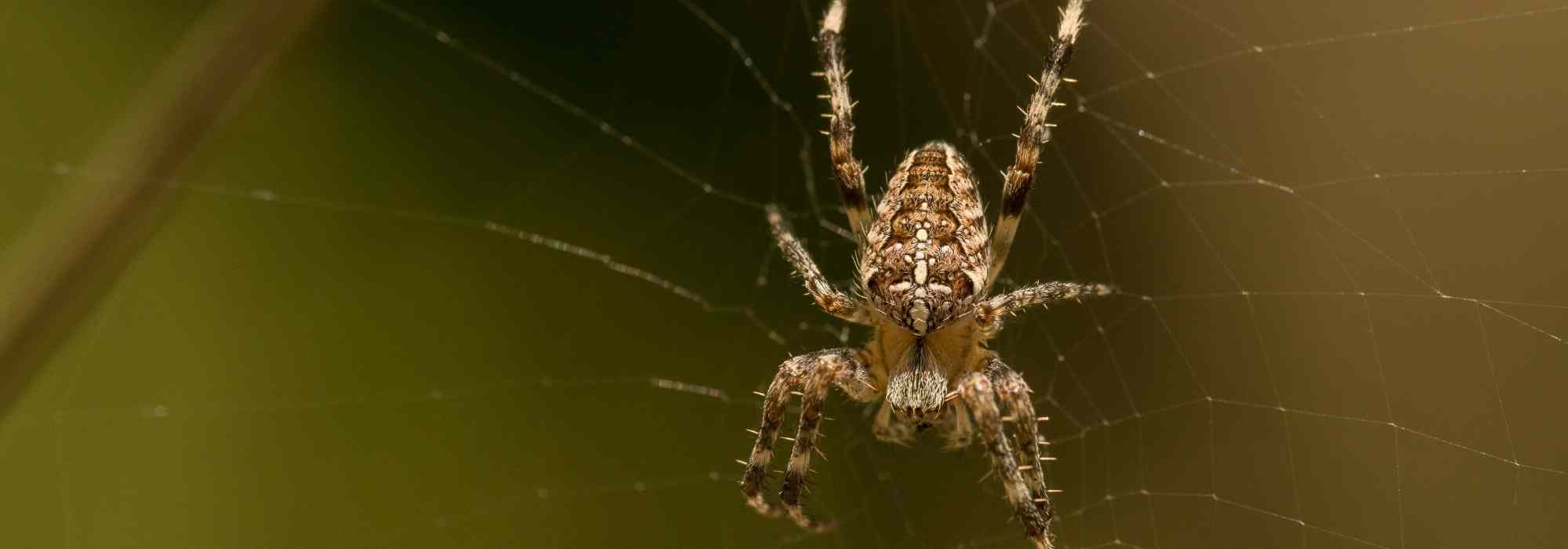
Spiders in the garden: why we should leave them alone?
Description of different species of spiders, their way of life, and their usefulness in the garden
Contents
Arachnophobes, look away, as this text may send a few shivers down your spine! Spiders (which, as a reminder, are not insects but arachnids) often evoke an unreasonable and irrational fear in the most timid. This bad reputation is completely unjustified, as, in our latitudes, there are no spiders to fear (except for the European black widow). Whether they live primarily indoors or in our gardens, orchards, vegetable patches, or on our balconies or terraces, spiders are omnipresent around us, usually invisible, but of great utility.
Discover the most common species of spiders found in the garden, their role in the ecosystem, and why it is essential to preserve them.
The main species of spiders found in French gardens
There are approximately 1600 different spiders in our territory. And this diversity is certainly still underestimated! It goes without saying that their inventory could prove to be very lengthy. However, these spiders are classified into different families that allow us to distinguish them.
The Araneidae
The Araneidae, among which the very common garden spider (Araneus diadematus) is a very common spider in our environment. These spiders build vertical spiral webs in the centre of which they lie in wait, head down. If the web breaks, they completely remake it, not without having eaten the old one to feed on the amino acids it contains.
The Araneidae are relatively large spiders (up to 5 cm for some!) that adopt different appearances from one species to another.
The Tegenaria
If the house spider (Tegenaria domestica) lives indoors, many other species of Tegenaria like to take refuge in dark corners of the garden, such as a woodpile, dead leaves, a low wall, herbs, or low vegetation… They weave horizontal webs, recognisable by the funnel in which they hide.
Tegenaria are often impressive spiders due to their long legs and black bodies. However, they only attack small prey.
The Green Micrommata
As their name suggests, these small spiders from the Sparassidae family have an emerald green body that makes them completely invisible when they are lying in wait on a leaf. These spiders do not weave webs but patiently wait for their prey in the vegetation. They are wandering spiders.
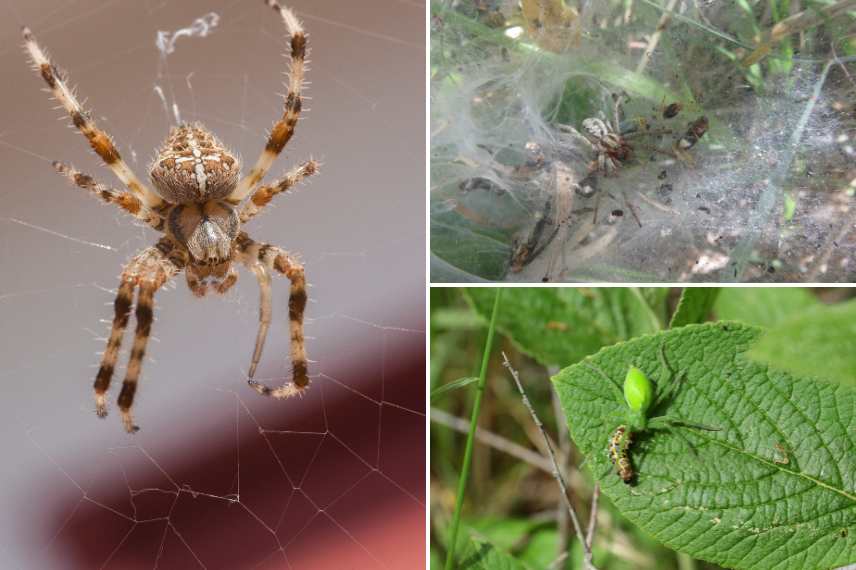 Clockwise, a garden spider, a Tegenaria, and a Micrommata
Clockwise, a garden spider, a Tegenaria, and a Micrommata
The Crab Spiders
Also known as Thomisidae, these spiders have the characteristic of having longer front legs than their hind legs. This characteristic forces them to move sideways, like a crab. These spiders do not weave webs but frequently station on flowers, taking on their colour.
The Argiopes
The Argiopes are spiders from the Araneidae family, often coloured black and yellow. They weave vertical and circular webs, usually sticky, in the centre of which they wait for their prey. They particularly enjoy sunny and humid areas, such as meadows, groves, or fallow land.
The Jumping Spiders
These are small spiders from the Salticidae family, without webs. They stand out due to their excellent vision for hunting. They are even capable of memorising their environment. Due to their small size, they can be mistaken for ants. They also have the ability to jump, either to hunt or to flee.
The Wolf Spiders
Also known as Lycosidae, these spiders move on the ground to track their prey and do not weave webs. They are beige or brown spiders. Females carry their brood with them.
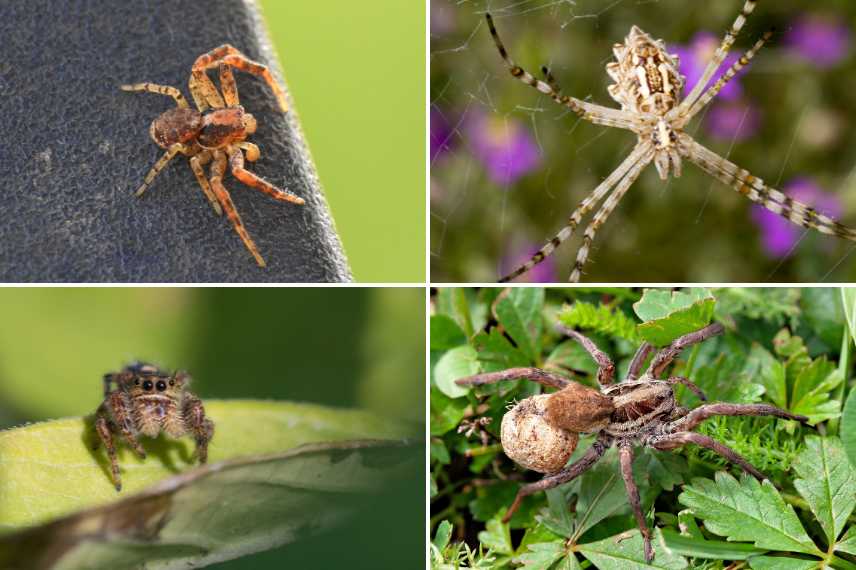 Clockwise, a crab spider, an argiope, a jumping spider, and a wolf spider
Clockwise, a crab spider, an argiope, a jumping spider, and a wolf spider
The case of the European black widow
All spiders found in France are harmless, except for the European black widow (Latrodectus tredecimguttatus), also known as the malmignatte or Mediterranean black widow. A final vernacular name that reflects its location. It can be found in the South and Corsica, but it has also been spotted along the Atlantic coast. It lives under stones, in tree roots, or in plants.
It is a venomous spider that can be recognised by its black body, punctate with red spots, sometimes orange or yellow. Generally, it bites when disturbed or attacked. Its venom, containing alpha-latrotoxin, causes various symptoms such as nausea, swelling, abdominal pain, headaches, excessive sweating…
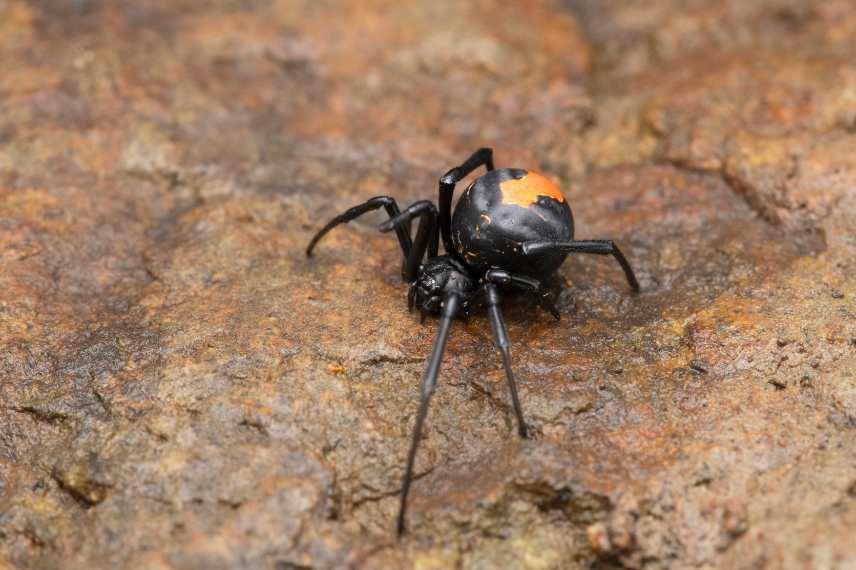 The European black widow
The European black widow
This venom, injected in small quantities, is not fatal, except in allergic individuals. However, it is strongly recommended to consult a doctor in case of a confirmed or suspected bite.
The essential role of spiders in pest regulation
In a healthy garden, the presence of spiders is a valuable indicator of biodiversity. Indeed, spiders are pure carnivores, never touching the plants in the vegetable garden, ornamental garden, or orchard. Instead, they play a central role as generalist predators, constantly intervening in the regulation of insect populations. Unlike some specialised auxiliaries like ladybird larvae or lacewings, spiders do not target a single type of prey. They capture whatever comes within their reach, as long as the size is suitable for their own morphology. This lack of specialisation makes them opportunistic and effective predators of pests.
Their diet is vast: flies and gnats, mosquitoes, small beetles, whiteflies, psyllids, thrips, winged aphids and scale insects, butterflies and young caterpillars, crane flies, and even a few individuals of dreaded pests like leafhoppers, cabbage whites, box tree moths, or certain moths. As a result, they limit outbreaks of pest insects and actively contribute to the biological balance of the garden. Their presence in greenhouses, flower beds, or fruit trees is therefore a significant asset, albeit a very discreet one.
The impact of this predation is all the more important as spiders are active during periods when other auxiliaries are still scarce. From the first days of spring, certain species can be observed hunting on the foliage or in the litter layer, well before the populations of hoverflies or ground beetles are fully established. Conversely, several species continue their activity well into autumn, extending regulation beyond the peak season.
They are also important because they have their place in the food chain. Many birds, mammals, amphibians, and reptiles also feed on them.
Spiders, effective hunters with varied strategies
The diversity of spiders is not limited to their shapes or colours. It is primarily manifested in their hunting strategies, remarkably adapted to the different mediums of the garden. This behavioural diversity allows spiders to occupy all ecological strata, from the soil to the heights of trees, from the vegetable garden to dry stone walls.
Orb-weaving spiders, such as the garden spider, construct circular webs suspended between stems or vertical structures. These traps are formidable for capturing flying insects. The central thread of the web, sensitive to vibrations, alerts the predator who waits in retreat. This method is particularly effective in late summer, when populations of flies or winged aphids reach their peak.
Other species, known as hunting spiders, adopt a mobile approach. They do not weave webs to trap, but actively spot, pursue, and capture their prey. This is the case for small jumping spiders that move visually on walls, leaves, or warm stones. Their excellent vision and agility make them predators targeting fast insects such as fruit flies, winged ants, or young shield bugs.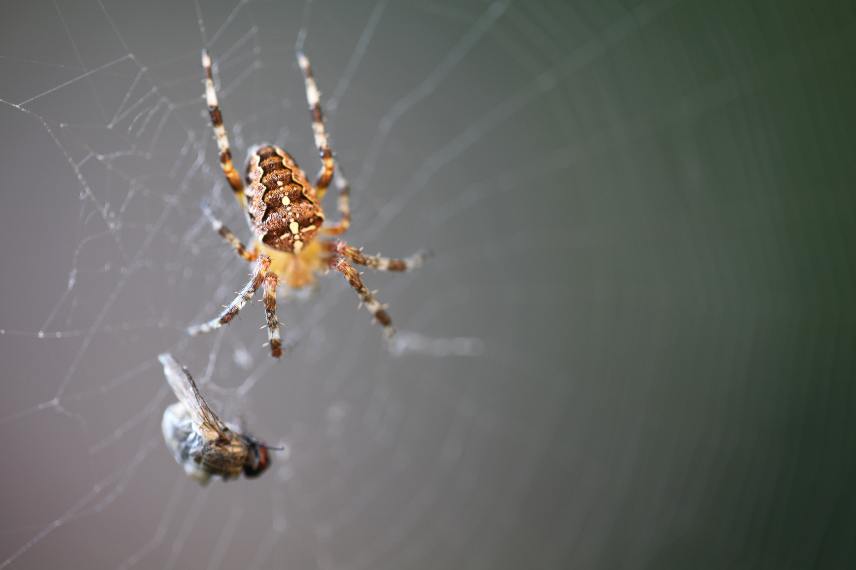
Some spiders prefer to lie in wait. This is the strategy of the crab spider, which blends into a flower or foliage, motionless, waiting for an unwary pollinator to come within reach. Despite occasional predation on solitary bees or hoverflies, its impact remains marginal and contributes to the regulation of harmful insects.
Finally, a large number of species adopt mixed or opportunistic techniques. The Tegenaria, for example, weave dense sheets of web in dark or little-frequented places. Their funnel-shaped structure allows them to trap weak crawling or flying insects.
How to encourage the presence of spiders in the garden?
The presence of spiders in the garden is therefore a tremendous asset in terms of biological control. The more timid should be reasonable in accepting their presence. Others can create conditions conducive to their arrival:
- The elimination of plant protection products, even those of natural origin, as they are very harmful to spiders. Non-selective insecticides and fungicides reduce food resources by killing prey or altering their behaviour.
- The maintenance of refugium areas. Spiders are sensitive to the structure of their environment. Piles of wood, heaps of stones, old walls, stumps, and dense hedges provide numerous micro-habitats where they can develop, reproduce, and hibernate. These elements should remain in place for several seasons to be truly effective. One can also adopt the principle of differentiated mowing

- The preservation of vegetation in winter, particularly hollow stems, faded perennials, or tall herbs at the edges. These supports serve as hiding places for many species, especially for egg cocoons or juveniles in the growth phase. A delayed pruning, carried out at the end of winter, allows populations to survive without being disturbed.
- The conservation of webs in garden sheds, attics, garages, chicken coops, wood shelters… and nests in the form of silk cocoons.
- The diversification of environments by alternating dry and wet areas, shaded corners and sunny spaces, dense vegetation and open zones… to please everyone.
- Subscribe!
- Contents
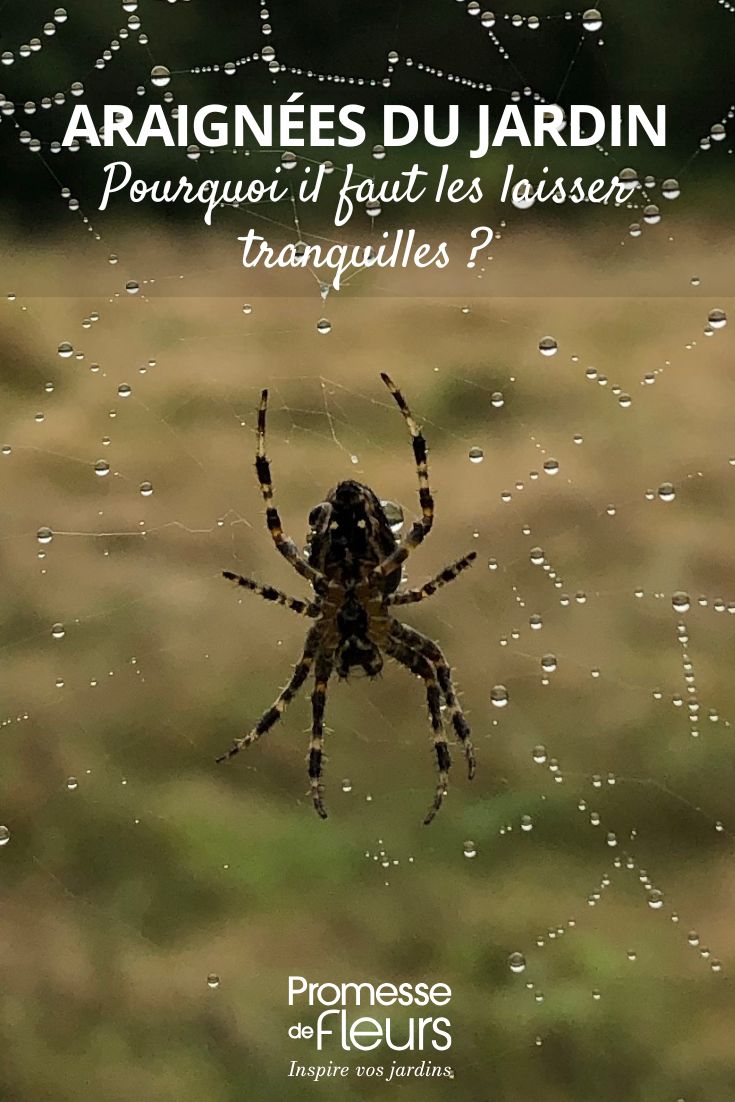































Comments